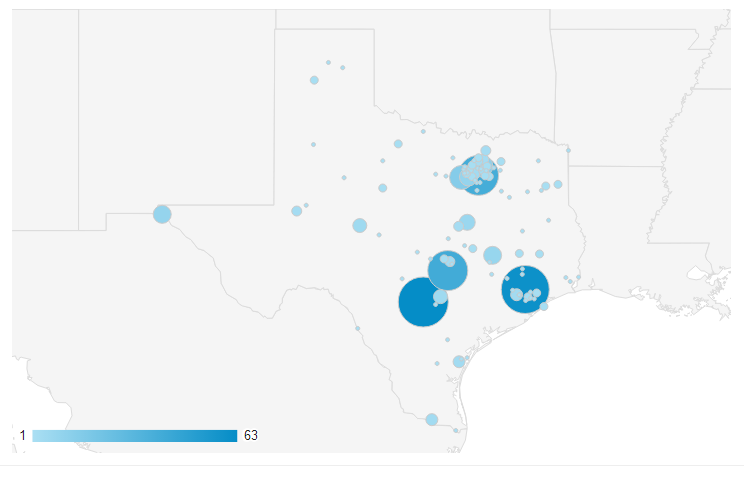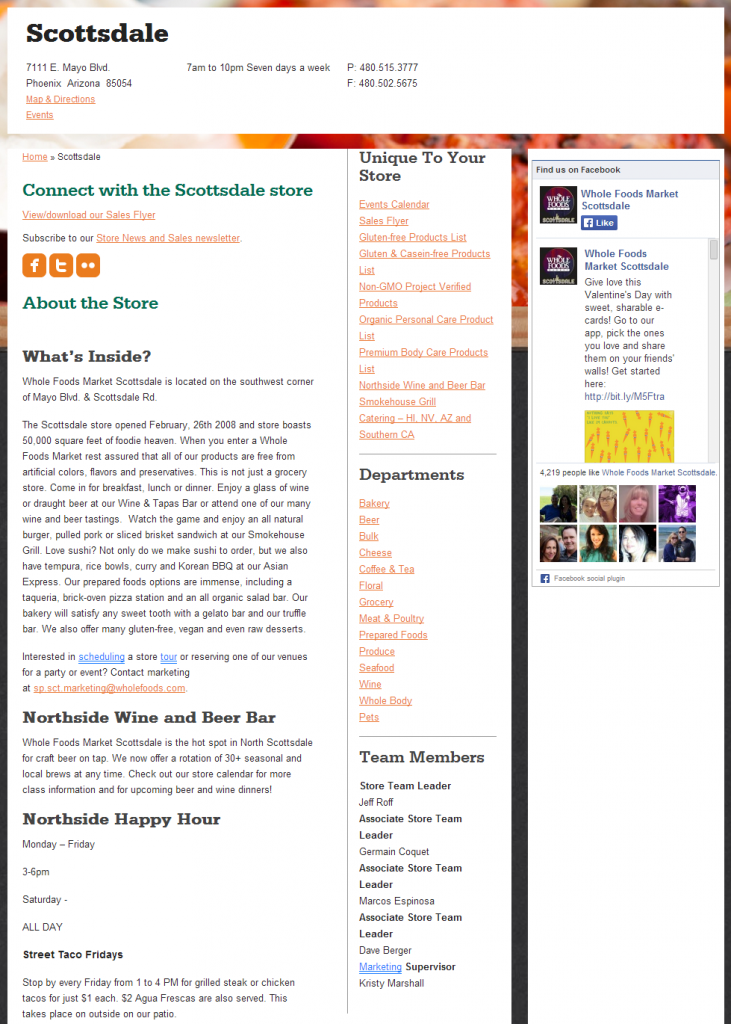Editor’s Note: This article was originally published by Web Marketing Today. Practical Ecommerce acquired Web Marketing Today in 2012. In 2016, we merged the two sites, leaving Practical Ecommerce as the successor.
Search engine optimization for local businesses can be difficult. That is especially true for companies with multiple locations.
But local SEO for small businesses with multiple locations isn’t impossible. It simply requires a highly organized plan based on your business’s goals and geographic priorities.
Here are five steps to improve your local organic traffic, and, more importantly, provide a better user experience to potential customers searching in a specific location.
1. Perform a Location-based SEO Audit
Before you know what to improve, you’ll need to know where you stand. Performing a basic geographic SEO audit allows you to see which locations offer you the most room for improvement.
Let’s say you work for a family law firm with physical locations throughout Texas. Perform basic Google searches (“Austin divorce attorney”) for the cities you wish to rank well in. For each city search, note whether your Google Places map listing appears, or if your website appears within the first few pages of results.
This should provide an idea of where your website ranks organically in each city, keeping in mind that factors like location and personalized results will change your exact ranking in search results.
If you have Google Analytics installed on your site, you can also cross-check the location of your website visitors to get an idea of your geographic breakdown, as seen in the image below.

Google Analytics’ location graph shows where visitors reside.
2. Determine your Location Priorities
Ideally, you’ll want to rank well for all of your locations. But if time or resources are limited, prioritize your efforts. One way to do this is to get an idea of the demand for your services in each area.
Use Google’s Keyword Planner to research keyword demand and competition in each location.

Google Keyword Planner identifies the frequency of search terms.
In the example above, there are far more searches for divorce attorneys in Austin than there are in San Antonio and Arlington. Although this data isn’t necessarily accurate, you can use the average monthly searches provided by Google in relation to all your keywords to build a prioritized list.
You can also consider the “Suggested Bid” in this data. This is an estimated dollar amount that Google recommends to show a paid search ad for this keyword. There isn’t a perfect correlation between this paid search data and organic search results. But, in general, keywords with higher bids are more competitive than those with lower bids.
When you’re prioritizing your locations list, balancing the average number of searches, competitiveness of the keyword and your current standing in the city should all be considered. For businesses with only a handful of locations, this isn’t difficult, but it’s important for businesses with many locations to manage.
3. Give Each Location a Unique Page
In 2010, Matt Cutts, head of Google’s webspam team, recommended that businesses have a unique page for each of their locations. This still holds true today. It is one of the most important parts of local SEO success.
If you have five locations in five cities, each location should have its own page on your website. Each page should be:
- Easily found on your website;
- Unique and specific to the location;
- Optimized to rank for your services and location.
Cutts notes that the location pages should be “easily crawlable,” which means accessible both to visitors and search engines. By providing unique information on each page, you’ll avoid duplicate content that often plague businesses with multiple locations.
How can a business create unique and locally-optimized pages? By providing information specific to that location. This includes the basic information: address, phone number, email addresses, and so on. But it also means providing a user experience that is clearly tied to that location.
Whole Foods Market does a good job of customizing local pages. Its Scottsdale, Ariz. location page contains:
- Location-specific social media accounts;
- Location-specific events calendar, flyers and promotions;
- The names of employees at the Scottsdale location;
- Background information about that particular location.
The problem for many businesses is that one location does not differ significantly from another. In this case, you can often go outside of your specific company to offer relevant but expanded location-based content.
In the example below, the family law practice at JacksonWhite Law (my employer) has a Gilbert, Ariz. location and offers localized information in the form of contact information for Gilbert organizations and departments that a potential client might find relevant.

JacksonWhite, a law firm, shows local community information on its Gilbert, Ariz. page.
You can also do this by posting local news blurbs or blogging about local events in the community that are related to your industry.
You can also link to business directories, profile sites, social media networks, or other third-party sites that mention your location, such as Yelp and Google+.
Additionally, you can mark up the contact information by using Schema, a system of HTML tags that helps search engines determine what data is on a web page. By using Schema’s “Place” markup on your location pages, you can help Google and other search engines know that this is a specific branch of your business. Schema markup can be added to identify your business’s address, contact information, hours of operation, and other business data.
4. Complete your Profile on Google Places for Business
With your local pages set up, it’s time to focus on off-site efforts. This should begin with Google Places for Business, an important factor in local rankings.
Google Places for Business is where you’ll add your business listing, update information and, if you’d like, create a Google+ Local page for your business, where you can focus on the social media aspects of your online marketing.
To get started, search for your address in Google’s database. If your business appears, you’ll have the opportunity to verify your profile and update your listing. If no business appears, you’ll click “No, these are not my businesses,” where you can then create your Google Places profile from scratch.
The keys to a good Google Places profile are accuracy and thoroughness. The accuracy of your contact information and business category are of the utmost importance. For your listing to show up properly, you must tell Google precise information about your business.
With inconsistent contact information or misplaced categories, your business will not show up in relevant searches, and is likely to not show up at all.
It’s also important to be as comprehensive as possible. The more information you provide, the more Google has to work with. Your Google Places page should include the following.
- Business name, address and phone number.
- Service areas and other location-related information.
- Hours of operation.
- Payment options.
- Photos of your business.
- Additional details relevant to your customers.
Google continues to experiment and update its local results. Features like the Knowledge Graph carousel make it clear that the success of your local listing depends a lot on how well you build it out.
When linking your Google Places profile to your main site, always link to the location-specific page. Your Google Places Houston profile, for example, should link to your Houston page.
Including professional images and as much information as possible helps Google and users understand your business and its locations better. And lastly, it’s important to use Google Places verification process, whether it’s by phone or postcard, which typically arrives within 1 to 2 weeks.
Lastly, although Google is the most popular search engine, but it’s also a good idea to set up similar profiles with Bing and Yahoo.
5. Gather Reviews for Each Location
Reviews are an important part of local SEO success. But they’re notoriously difficult to manage in any easy, scalable way, particularly for businesses with multiple locations.
Generating legitimate reviews can be a part of your natural sales and marketing efforts. Whether you deal with customers online or offline, you can easily ask them to share their experience on major review sites like Yelp, Google Places, or other business directories.
The quantity and quality of reviews you receive matters, as well as how fast you accumulate them. Essentially, the more reviews you receive, the easier it is for Google to determine your site’s value and relevance.
It also helps on the user end, as well. When your listing shows up beside your competitors’ and your reviews are more highly rated, it can lead to an increased click-through rate.
For businesses with multiple locations, it’s important to seek reviews for each of your locations, at least for the major business sites. You can make this process more efficient by providing specific profiles to your customers.
If you have five locations, for instance, don’t simply tell your customers to review you on Yelp. Offer the information for a location’s specific profile and make the review process as easy as possible for them.
Putting it Together for Local SEO Success
When you have multiple business locations, you’re competing with far more websites than you would be if you were in one area. This makes local SEO extremely competitive, but also very profitable when done correctly.
Utilizing these five steps can create the structure you need to improve your organic rankings and offer your audiences in each location the type of specialized information they need to make an informed online decision.




